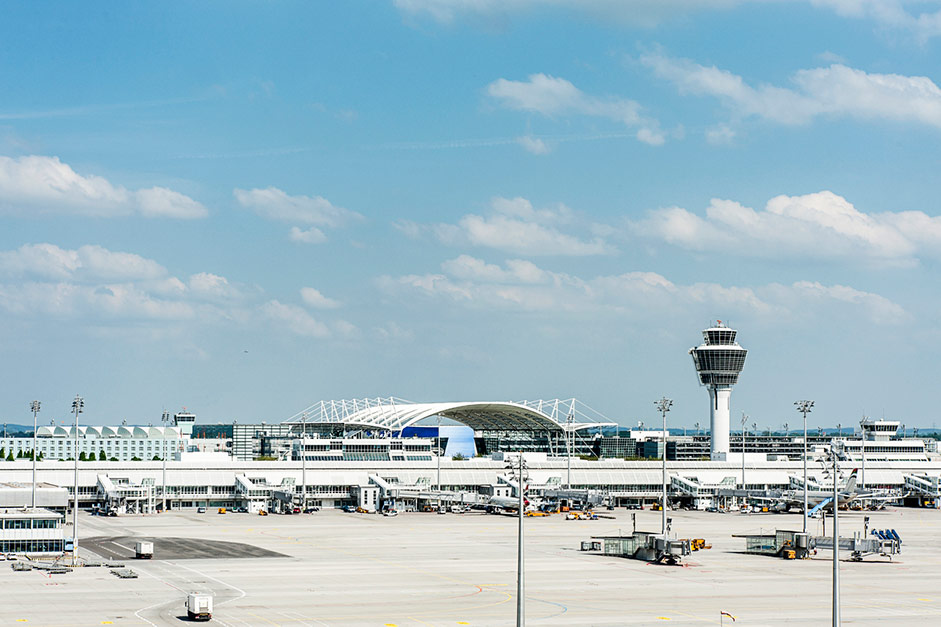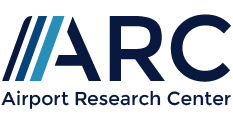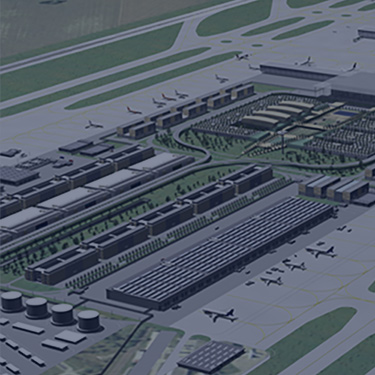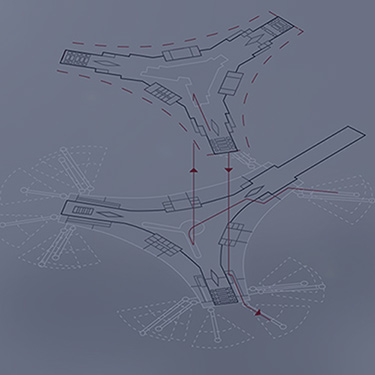Glossary & Definitions
Airport Capacity
- Amount of air traffic, passengers and vehicles which an airport system comprising airside, terminal and landside access can accommodate per unit of time
- Airport capacity is defined by the maximum capacity of the weakest element of the airport
- CAST Simulation suite with its Aircraft, Terminal and Vehicle modules can be deployed to determine the system capacity of the limiting element
Airside Capacity
- Airside capacity is the amount of air traffic which an airport’s airside system comprising runways, taxiways and aircraft stands can accommodate per unit of time
- Airside capacity is defined by the maximum capacity of the weakest element of the airside
- CAST Aircraft simulation is widely used for the assessment of airside capacity
Runway Capacity
- The runway capacity is defined as the number of aircraft movements, which can be handled by a runway, final approach and SID system of an airport under defined conditions as structure of the traffic demand, operational concept, weather conditions and ATC rules
- Can be determined as practical capacity or as maximum/saturation capacity using analytical methods or – for higher accuracy – simulation
- Usually runway capacity is stated as the total number of landings and take-offs per hour
- With CAST Aircraft the runway capacity can be determined considering also complex dependencies under various conditions in order to generate a stable baseline for capacity planning and capacity optimisation.
Passenger Terminal Capacity
- Airport terminal capacity is defined as the maximum number of passengers, flights, or baggage a terminal can efficiently handle within a given timeframe.
- It is influenced by factors such as check-in, security screening, boarding gates, baggage handling, passenger flow management and the quality requirements defined by the Level Of Service (LoS). Bottlenecks in these processes can limit overall capacity and affect airport operations.
- CAST Terminal Simulation enables detailed analysis and optimization of terminal capacity, helping airports enhance passenger experience and operational efficiency.
Airport Capacity Planning and Assessment
- Comprises activities related to the capability of an airport system or it’s components to handle a certain demand in flight and passengers
- Overall objective is the demand-oriented, balanced and sustainable use and development of infrastructure and operational procedures, taking into account economic, environmental and qualitative corporate objectives
- Comprises the long term strategic planning and development of the infrastructure, the medium term and tactical adaptation and the short term optimisation of the airport system also considering operational concepts, procedures and supporting tools
Strategic, tactical and pre-operational:
CAST Terminal
CAST Aircraft
CAST Vehicle Ground Handling
CAST Vehicle Landside
CAST Stand & Gate Allocation
Pre-operational and operational:
Pax Flow Solution powered by CAST
Security Management Solution powered by CAST
APOC Simulation Solution powered by CAST
CAST Express
With this glossary we would like to give short, basic explanations and definitions for important and frequently used terms in the fields of Analysis, Runway and Terminal Capacity Assessment and Airport Simulation/Allocation. These are based on our experience of practical application in the industry. We would be happy to provide you with more detailed definitions and further explanations. Please feel free to contact us.

Airspace Capacity
- Amount of air traffic movements which can be handled by a structure of STAR, approach and SID airspace routes under conditions such as ATC concepts and flight rules (VFR vs IFR)
- Airspace capacity is defined by the maximum capacity of the weakest element of the airspace and runway
- CAST Aircraft simulation allows for the assessment of airspace route and sector throughput under dynamic circumstances
ATC Capacity
- Capability of Air Traffic Control (ATC) to handle air traffic movements (ATM) in the airspace sectors (sector load), taking into account factors such as controller workload and equipment
Maximum Capacity (Ultimate Capacity / Saturation Capacity / Technical Capacity)
- The maximum capacity is also referred to as ultimate capacity, saturation capacity or technical capacity
- It is defined as the maximum number of throughput through a system under defined conditions
- It assumes continuous demand, which in reality can only be reached by accepting high delays
Aircraft Stand Capacity
- Aircraft stand capacity is the amount of turnarounds which the airside aircraft parking positions can accommodate at any given moment and per unit of time, depending on parameters such as turnaround times, traffic mix, aircraft stand dependencies and allocation priorities
- Often expressed per ICAO code letters (A-F) or as equivalents in case of MARS stands (e.g. counted as 2 category C stand or 1 category E stand)
- CAST Stand and Gate Allocation offers long and short term stand and gate planning as well as demand and capacity analysis considering complex soft and hard rules
Gate Capacity
- Amount of flights which the terminal infrastructure can handle based on gate availability
- Distinction is made between arrival and departure gate capacity, as well as the gate status in terms of border control and aviation security
- Gate capacity/utilisation can be increased by application of swing gates
- CAST Stand Allocation can be applied to allocate comprehensive flight schedules and ascertain the operational availability of gates. Parameters taken into consideration concern stand geometries/limitations, complex gate/stand dependencies and the gate statuses in terms of border control or aviation security.
Practical Capacity
- In a generic sense, the definition of Practical Capacity is the throughput which can be accommodated for a sustained period of time by the airport infrastructure while not exceeding a defined level of delay. Due to the uneven distribution of the demand, acceptance of higher delays lead to a higher Practical Capacity. The Practical Capacity is always below the Technical or Saturation Capacity.
- For the runway and airside it is the number of aircraft movements which can safely be operated, usually stated as the total number of landings and take-offs per hour. For the terminal it is the number of passengers, usually stated as the number of departing and arriving passengers per hour.
- CAST provides tools for simulation based capacity determination including airspace, runway- and taxiway system, stands and gates, the passenger terminal and the landside of an airport
Declared Capacity
- Declared capacity is defined as the limit on the maximum traffic flow that an airport can accept taking into account the airport system as a whole (TMA, runway system, taxiways, parking areas, terminal, road and rail access) and certain external constraints (environment, noise, political constraints, etc.).
- The declared capacity is therefore an administratively determined measure that limits the accessibility of the airport. It is the basis for the relevant decision-making bodies to allocate slots to airlines and is below the technical capacity.
- Declared capacity is stated as the total number of landings and take-offs per hour but also for smaller time intervals as 30min or 10min in order to enhance operational flexibility. Especially if the technical limits of the capacity are to be reached, detailed simulation-based evaluations are necessary to achieve the optimum values for the Declared Capacity.
- CAST Aircraft simulation is widely used and recommended by the Slot Coordination Authorities to determine the technical components for the Declared Capacity and also complies with EU recommendations to use commonly accepted technical methods.
Airport Coordination
- In those cases when the air traffic demand exceeds the available airport capacity, an airport has to be(come) slot coordinated. In this way, the operational performance and congestion of the airport remains within acceptable levels. This is achieved through a system with ‘slots’, which ensure the demand can be controlled.
- CAST Aircraft simulation is widely deployed to ascertain declared slot coordination capacity and the pertaining operational performance in terms of airside delay
Level of Service (LoS) for Passenger Terminals
- Level of Service (LoS) for airport terminals is a standard for assessing passenger experience and operational efficiency, typically defined by factors such as queue times, space per passenger, and processing speeds at check-in, security, and boarding areas.
- LOS classifications range from optimal (free-flowing) to unacceptable (overcrowded), influencing terminal design and capacity planning.
- Achieving a high LOS is crucial for passenger satisfaction, regulatory compliance, and competitive positioning among airports.
- CAST Terminal Simulation allows airports to evaluate and optimize LOS, ensuring efficient operations and an improved passenger experience.
Level of Service (LoS) for Airside Operations
- Level of Service (LoS) for airside operations measures the efficiency and capacity of critical airport airside processes, including runway usage, taxiway flows, apron capacity, and aircraft turnaround times.
- It is influenced by factors such as congestion, air traffic control procedures, stand availability, and ground handling efficiency.
- Maintaining a high LOS ensures minimal delays, optimized aircraft movements, and increased operational resilience.
- CAST Airside Simulation enables airports to assess and enhance LOS by identifying bottlenecks and improving overall airside performance.
On-Time Performance (OTP)
- On-Time Performance (OTP) describes a widely accepted method of understanding punctuality for different modes of public transport
- An airline is considered to be on time if the departure or arrival takes place within 15 minutes of the scheduled time
Aircraft Turnaround Time
- Aircraft turnaround time is the duration between an aircraft’s arrival at a gate and its departure for the next flight. It includes processes such as passenger boarding and deboarding, baggage handling, refueling, catering, and maintenance. Efficient turnaround times are critical for maintaining airline schedules and reducing operational costs.
- CAST Vehicle Ground Handling Simulation helps airports and airlines optimize turnaround procedures, minimizing delays and improving efficiency.
Aircraft Turnaround Time
- Aircraft turnaround time is the duration between an aircraft’s arrival at a gate and its departure for the next flight. It includes processes such as passenger boarding and deboarding, baggage handling, refueling, catering, and maintenance. Efficient turnaround times are critical for maintaining airline schedules and reducing operational costs.
- CAST Vehicle Ground Handling Simulation helps airports and airlines optimize turnaround procedures, minimizing delays and improving efficiency.
Variable Taxi Time (VTT)
- Variable Taxi Time (VTT) is the estimated time that an aircraft spends taxiing between its parking stand and the active runway or vice versa
- Generic name for both incoming (EXIT) and outgoing (EXOT) taxi time parameters, used to calculate the Target Takeoff Time (TTOT) or the Target Start Up Approval Time (TSAT)
- Inbound taxi time (EXIT) includes runway occupancy and ground movement time, whereas outbound taxi time (EXOT) includes push back & take-off time, ground movement, remote or apron de-icing and runway holding times
Linkage of Flight Schedules
- Linkage of flight schedules refers to the strategic coordination of arriving and departing flights to optimize connectivity, minimize turnaround times, and enhance passenger or cargo transfers.
- This process is crucial for hub-and-spoke operations, airline scheduling efficiency, and airport capacity planning.
- Factors such as aircraft rotation, gate availability, and slot management influence effective schedule linkage.
- CAST Airport Simulation enables the evaluation and optimization of flight schedule linkages, helping airports and airlines improve operational efficiency.
Artificial Intelligence / Digitalization
- Artificial Intelligence (AI) and Digitalization at airports is defined by the combination of new technologies and huge data feeds in order to detect, analyze, simulate, predict, control and allocate resources and flows. It can cover the whole system from flight operations over passenger flows to baggage handling and cargo operations.
- With an APOC AI-based solution, airports are enabled to analyze and interpret a huge amount of information in a short time, quickly evalute potential options and thus facilitate better decisions.
- Solutions powered by CAST combine AI and deep learning technologies in ordert to predict, manage and optimize opertations, leading to an agile and flexible management, reduced costs and a better passenger experience.
Find more information on:
https://arc.de/cast-solutions/
Digital Transformation
- The definition of Digital Transformation in the context of flow management and resource planning is about the integration and application of new (digital) technologies into the airport system in order to provide:
-
- a better passenger and customer experience
- demand and capacity balancing
- flexibility and agility in resource management
- integrated, collaborative decision making
- disruption management and risk mitigation
- significant cost savings
-
- Based on big data analysis and AI modelling demand and capacity prediction tools provide the baseline for an informed decision making and agile management and resource planning.
- Within this context CAST Software and Solutions powered by CAST are one core element of digital transformation and facilitate prediction and scenario based decision making on the strategic, tactical and operational level.
Urban Air Mobilty Abbreviations
UAM – Urban Air Mobility
UAM stands for Urban Air Mobility, which refers to the transportation of people and goods by air in the urban environment. The term is also frequently used in the context of new air transport concepts such as air cabs or drones.
Urban air mobility is regarded as one of the potential megatrends of the upcoming years with the potential to make inner-city travel faster and hassle-free while reducing congestion on the ground and thus CO2 emissions.
UA/UAV – Unmanned Aircraft (Vehicle)
UA resp. UAV stands for Unmanned Aircraft (Vehicle) and refers to autonomous flying aircraft types such as drones or air cabs that no longer require a pilot.
The terms are used synonymously with the abbreviations UAS / UAVS which stands for Unmanned Aircraft (Vehicle) Systems.
Smaller unmanned aircraft types with less than 25kg take-off weight are also described as sUAS (small Unmanned Aircraft System).
SUPPORT BY ARC
ARC offers drone manufacturers and operators, network planners and regulators, cities and airports detailed process planning, simulation services and expert consulting in operations and technical studies (read more).
We would be happy to provide you with more detailed information and case studies. Please feel free to contact us.
RPA / RPAS – Remotely Piloted Aircraft (Systems)
RPA resp. RPAS stands for Remotely Piloted Aircraft (Systems) and is a subset of the more general category UA / UAS which stands for Unmanned Aircraft (Systems)
eVTOL – electrical Vertical Take-off and Landing (Vehicle)
The term describes a subcategory of UAV and is characterized by the ability to vertical take-off and landing with electrical power supply.
Because of the low space requirements for landing and low noise emissions, this category is well suited for (sub-) urban areas.
U-Space
U-Space provides a framework that maps the implementation of manned and unmanned flight operations in all classes of airspace to maintain safe flight operations.
The USSP (U-Space Service Providers) monitor UAV (Unmanned Aircraft Vehicle) operations in a U-Space and serve as an interface between manned and unmanned aviation and are thus a prerequisite for the establishment of a U-Space.
UTM – Unmanned Traffic Management
UTM (Unmanned Traffic Management) stands for new air traffic management systems which also include UAVs (Unmanned Aircraft Vehicles) and associated special challenges in existing air traffic management systems.

















